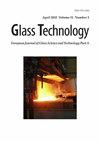《罗斯维克沉船》,古德温·桑兹:18世纪玻璃瓶的检验与分析
IF 0.3
4区 材料科学
Q4 MATERIALS SCIENCE, CERAMICS
Glass Technology-European Journal of Glass Science and Technology Part a
Pub Date : 2022-01-01
DOI:10.13036/17533546.63.3.003
引用次数: 0
摘要
#Rooswijk1740项目由荷兰文化遗产局(教育、科学和文化部)资助和领导,与项目合作伙伴Historic England和英国承包商MSDS Marine合作。1740年,荷兰东印度公司(VOC)印度人在古德温沙漠(Goodwin Sands)上丢失了Rooswijk,通过微x射线荧光(XRF)光谱和扫描电子显微镜(SEM-EDS)分析,对17个玻璃瓶的氧化物成分进行了测定,重点分析了瓶子的来源。其中三个瓶子样品被确定为可能来自英国,并且是同一批次的一部分。大多数瓶子可能来自欧洲大陆,至少有两瓶可能来自荷兰,尽管它们的确切来源无法确定。本文章由计算机程序翻译,如有差异,请以英文原文为准。
The Rooswijk wreck, Goodwin Sands: Examination and analysis of 18th-century glass bottles
The #Rooswijk1740 project is funded and led by the Cultural Heritage Agency of the Netherlands (Ministry of Education, Science and Culture), in collaboration with project partner Historic England and UK-contractor MSDS Marine. The oxide compositions of 17 glass bottles recovered from the Rooswijk, a Dutch East India Company (VOC) Indiaman lost in 1740 on the Goodwin Sands, were determined by micro-x-ray fluorescence (XRF) spectroscopy and scanning electron microscopy paired with energy dispersive spectroscopy (SEM-EDS) analysis, focusing on the origins of the bottles. Three of the bottle samples were identified as of probable English origin and part of the same batch. Most of the bottles are probably from continental Europe, with at least two likely to be Dutch, although their precise origins could not be identified conclusively.
求助全文
通过发布文献求助,成功后即可免费获取论文全文。
去求助
来源期刊
CiteScore
0.30
自引率
0.00%
发文量
0
审稿时长
>12 weeks
期刊介绍:
The Journal of the Society of Glass Technology was published between 1917 and 1959. There were four or six issues per year depending on economic circumstances of the Society and the country. Each issue contains Proceedings, Transactions, Abstracts, News and Reviews, and Advertisements, all thesesections were numbered separately. The bound volumes collected these pages into separate sections, dropping the adverts. There is a list of Council members and Officers of the Society and earlier volumes also had lists of personal and company members.
JSGT was divided into Part A Glass Technology and Part B Physics and Chemistry of Glasses in 1960.

 求助内容:
求助内容: 应助结果提醒方式:
应助结果提醒方式:


